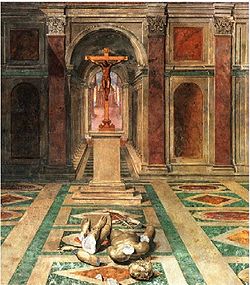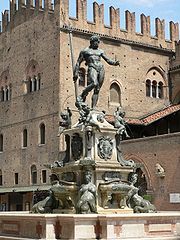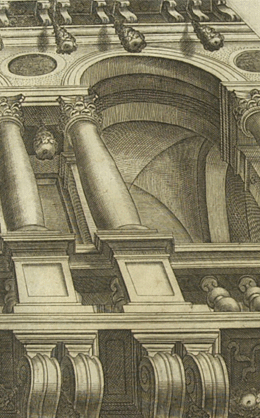
Tommaso Laureti
Encyclopedia

Italy
Italy , officially the Italian Republic languages]] under the European Charter for Regional or Minority Languages. In each of these, Italy's official name is as follows:;;;;;;;;), is a unitary parliamentary republic in South-Central Europe. To the north it borders France, Switzerland, Austria and...
painter from Sicily
Sicily
Sicily is a region of Italy, and is the largest island in the Mediterranean Sea. Along with the surrounding minor islands, it constitutes an autonomous region of Italy, the Regione Autonoma Siciliana Sicily has a rich and unique culture, especially with regard to the arts, music, literature,...
who trained in the atelier of the aged Sebastiano del Piombo
Sebastiano del Piombo
Sebastiano del Piombo , byname of Sebastiano Luciani, was an Italian Renaissance-Mannerist painter of the early 16th century famous for his combination of the colors of the Venetian school and the monumental forms of the Roman school.- Biography :Sebastiano del Piombo belongs to the painting school...
and worked in Bologna
Bologna
Bologna is the capital city of Emilia-Romagna, in the Po Valley of Northern Italy. The city lies between the Po River and the Apennine Mountains, more specifically, between the Reno River and the Savena River. Bologna is a lively and cosmopolitan Italian college city, with spectacular history,...
. From 1582, he worked for papal patrons in Rome in a Michelangelo-inspired style with special skill in illusionistic perspective that in his Roman work avoided all but traces of Mannerism
Mannerism
Mannerism is a period of European art that emerged from the later years of the Italian High Renaissance around 1520. It lasted until about 1580 in Italy, when a more Baroque style began to replace it, but Northern Mannerism continued into the early 17th century throughout much of Europe...
(Freedberg 1993:654).
Laureti was born in Palermo
Palermo
Palermo is a city in Southern Italy, the capital of both the autonomous region of Sicily and the Province of Palermo. The city is noted for its history, culture, architecture and gastronomy, playing an important role throughout much of its existence; it is over 2,700 years old...
. After his master's death in 1547, he settled in Bologna, introducing illusionistic perspective paintings on ceilings to the city , notably an Alexander the Great ceiling with a painted architectural setting in Palazzo Vizzani. He painted a Transportation of the body of Saint Augustine for San Giacomo Maggiore
San Giacomo Maggiore
San Giacomo Maggiore is a church in Bologna, central Italy. It was founded by the Augustinian Order in 1267 and houses, among the rest, the Bentivoglio Chapel, featuring numerous Renaissance artworks.-History:...
. The Mannerist structural elements of the marble and bronze Fountain of Neptune in Bologna, which is surmounted by Giambologna
Giambologna
Giambologna, born as Jean Boulogne, incorrectly known as Giovanni da Bologna and Giovanni Bologna , was a sculptor, known for his marble and bronze statuary in a late Renaissance or Mannerist style.- Biography :...
's Neptune, completed in 1566, were based on a 1563 drawing by Laureti. This commission from Pope Pius IV
Pope Pius IV
Pope Pius IV , born Giovanni Angelo Medici, was Pope from 1559 to 1565. He is notable for presiding over the culmination of the Council of Trent.-Biography:...
is undoubtedly Laureti's most familiar public work (illustration, left below).
In the Church of Santa Susanna, Rome, Laureti's painting of the Death of Saint Susanna is above the High Altar. His frescoes in the Sala dei Capitani in Michelangelo
Michelangelo
Michelangelo di Lodovico Buonarroti Simoni , commonly known as Michelangelo, was an Italian Renaissance painter, sculptor, architect, poet, and engineer who exerted an unparalleled influence on the development of Western art...
's Palazzo dei Conservatori on the Campidoglio, painted in 1587-94, depicted episodes from Roman history: The Justice of Brutus; Horatius Cocles defending the Pons Sublicius; Victory at Lake Regillus; Mucius Scaevola before Lars Porsena.

Council of Trent
The Council of Trent was the 16th-century Ecumenical Council of the Roman Catholic Church. It is considered to be one of the Church's most important councils. It convened in Trent between December 13, 1545, and December 4, 1563 in twenty-five sessions for three periods...
triumphalist theme, The Triumph of the Christian religion on the new vaulted ceiling of the Sala di Costantino or Hall of Constantine, where the walls had been frescoed by the school of Raphael earlier in the century. The ceiling was completed under the pontificate of Sixtus V, whose armorial devices were introduced into the frieze. The rigorous illusionistic perspectives represent a lifetime's fascination with the art of perspective.

Giacomo Barozzi da Vignola
Giacomo Barozzi da Vignola was one of the great Italian architects of 16th century Mannerism. His two great masterpieces are the Villa Farnese at Caprarola and the Jesuits' Church of the Gesù in Rome...
's, Le due regole della prospettiva pratica., 1583 (illustration, right).
In the Basilica di San Prospero, Reggio Emilia
Reggio Emilia
Reggio Emilia is an affluent city in northern Italy, in the Emilia-Romagna region. It has about 170,000 inhabitants and is the main comune of the Province of Reggio Emilia....
, his altarpiece of the Assumption was completed by Ludovico Carracci
Ludovico Carracci
Ludovico Carracci was an Italian, early-Baroque painter, etcher, and printmaker born in Bologna....
in 1602.
Laureti was the second principe or director of the Accademia di San Luca
Accademia di San Luca
The Accademia di San Luca, was founded in 1577 as an association of artists in Rome, under the directorship of Federico Zuccari, with the purpose of elevating the work of "artists", which included painters, sculptors and architects, above that of mere craftsmen. Other founders included Girolamo...
or the artists' academy in Rome, succeeding Federico Zuccari
Federico Zuccari
Federico Zuccari, also known as Federigo Zuccaro , was an Italian Mannerist painter and architect, active both in Italy and abroad.-Biography:Zuccari was born at Sant'Angelo in Vado, near Urbino ....
in 1595. His commemorative portrait by Orazio Borgianni, dated 1603, is in the Accademia di San Luca, Rome.
Sources
- Filippo Titi, , 1763
- (Getty Museum) "the Geometry of Seeing" 2002
- Laueti and the Sala di Costantino
- Roberto Piperno, "" G. Vasi's description, 1761.

